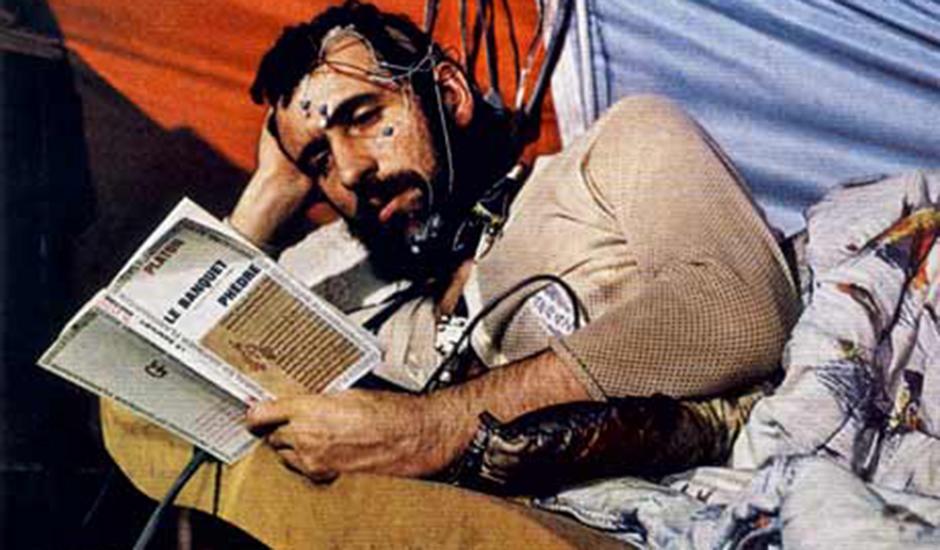Six months of imprisonment: synchronism, circadian rhythms and sleep disorders

ChNPP control panel
Ragged sleep and wakefulness is not typical for humans and can lead to fatal errors. For example, man-made disasters in Bhopal , Chernobyl and Three Mile Island occurred between midnight and four o'clock in the morning and were associated with inattention due to staff fatigue caused by disruptions in the body's daily rhythm.
Globalization sets up our society for a 24 hour mode of operation - financial markets are not asleep, factories operate around the clock, trade is conducted from dawn to dawn.
How it was investigated and what are the reasons for out of sync - I will begin to disclose in this article.
Many people know the lack of sleep of young parents in the first months after the birth of children. Often children are confused day and night, and sometimes they are so pronounced larks that they wake up with the first rays of the sun.
In fact, these problems with nighttime sleep and early awakening of children are difficulties in synchronizing internal rhythms with the rhythms of the surrounding world. Usually they come to balance by half a year.
')
But out of sync occurs not only in children, in recent times, more and more problems with beating sleep rhythms has been haunting adults.
In general, people manage to keep their rhythm for 24 hours and maintain synchronization with the outside world. But people living with blindness have problems with it, and their rhythms get off every three weeks, and the sleep and wakefulness pattern changes.
These cases only emphasize the importance of synchronism, which was developed in humans in the course of evolution, but which part of the body is responsible for the rhythms of the body?
Perhaps somewhere in the body there is an internal pendulum that adjusts the internal rhythms in accordance with the surrounding world, or each cell of the body synchronizes itself independently of the others, and maybe this is due to the connection between the brain and the eyes. Let's try to figure it out.

Imagine our bodies as a huge orchestra, where every cell of the body is a musician, and every musician has an innate sense of the 24-hour rhythm.
The performers are located in the kidneys, liver, pancreas and other organs, and they perform their biochemical concert for 24 hours. At different periods of time inside each organ, they can be both active and passive and work on the production and regulation of the level of hormones and proteins in the body.
The synchronization of the body consists of three steps:
- All cells of one organ are synchronized with each other and act together, changing chemical and electric rhythms simultaneously.
- Synchronism between different organs of the same organism - it is called internal synchronization. This does not mean that they work at the same time, but only means that they have a clear schedule of activities, built on dependence on each other.
- Synchronism between the body and the outside world.
How synchronism affects our life - today it is one of the most pressing issues, and most of all scientists are interested in its influence on sleep. Since the 1970s, several experiments have been conducted that have helped to understand at least something about synchronism and its effect on sleep.

Michel Sifr
So on February 14, 1972, Michel Sifr went underground into one of the Texas caves - Midnight Cave for half a year.
The French geologist was engaged in sleep research and volunteered to test the synchronism of the human body. He went to a cave for six months and isolated himself from any perception of time. This was not the first experiment to find the internal circadian clock of a man, but this time in more comfortable conditions.
Previously, there was a monthly stay in the Alpine cave in cold and darkness, and for the semi-annual experiment Sifre chose a cave with a stable temperature of 21 ° C, but for him everything ended even worse than in the Alps.
Being completely alone for half a year, the researcher almost went insane due to constant stress. In addition, after a while his player was out of order, and the books became unreadable due to mold. For at least some emotional relief, he tamed the mouse, feeding it with the remnants of the table, but their friendship soon tragically ended: Michelle crushed the mouse that trusted him, dropping a homemade cage from the pan on it.

On day 79 of the experiment, a geologist called the surface and begged colleagues to pull him to the surface, but he was denied this. After that, he began to appear thoughts of suicide.
Indicative was the effect of voluntary imprisonment and on the mental abilities of Michel. So on the last day of the experiment, electric shocks from faulty devices began to occur, but the researcher realized that the power was turned off only after the third discharge.
Sifre’s sacrifice was not in vain, and it was thanks to him that in the first five weeks his daily cycle was established at 26 o'clock. Every day he woke up later than the previous one, and so his schedule shifted more and more relative to the generally accepted 24-hour rhythm of life, but the daily routine did not change.
Another important observation was the change in body temperature during the day. So body temperature ranges from 36 to 37 degrees Celsius, regardless of our activities. The temperature drops before bedtime and rises shortly before waking up.
And although this was noticed as early as 1866, the Sifre experiment proved that fluctuations in body temperature are not related to the world around us and the time of day.
After establishing the 26-hour daily cycle, Sifr went to bed at the same time every day with a decrease in body temperature and woke up when the temperature rose.
Thanks to this experiment, it was proved that changes in body temperature are one of the important factors in setting the internal rhythms of the body.
At the first stage of the experiment, the Frenchman behaved in the same way that hamsters or drosophila behave in laboratories, when scientists isolate them from the time indicators for research.
The cycles of some animals are shorter than 24 hours, while others are longer. These cycles are called circadian rhythms and, for example, in a laboratory mouse, they are set at 23.5 hours, and mimosa opens and closes its petals with a 22-hour cycle. Almost all living organisms have their own stable rhythms, and in the absence of external prompts, they quickly set up on their own.
On the 37th day of the experiment, the circadian cycle Sifre lost its similarity with the rhythms of other animals and his body began to behave atypically, and the circadian rhythm became out of sync.
He stayed awake for hours after his body temperature dropped and didn’t sleep all night, and after that he could sleep for 15 hours, which is twice as long as his usual sleep time.
The whole next month, his schedule behaved unpredictably, then returning to the 26-hour cycle, then switching to 40 and 50 hours. At the same time, the researcher was not aware of these violations, and his body regularly changed body temperature in accordance with the 26-hour cycle.
These violations of cycles later became known as spontaneous internal desynchronization.
Internal out-of-sync means that circadian rhythms of sleep and body temperature begin to work separately in one organism, and it is observed only in humans, animals and plants are not affected by it.
Later it became known that the cycles of sleep and wakefulness of Sifre were not something unpredictable and obey simple mathematical rules, and all people are subject to disruptions to one degree or another.
Subsequently, experiments were conducted on the circadian rhythms of people, but I will write about them in another article.
Well, that's all for today. If you have any additions to the article - I will be glad to discuss in the comments.
Have a good day, sleep and stable rhythms!
Literature:
 “The rhythm of the universe. How out of chaos there is order in nature and in everyday life "
“The rhythm of the universe. How out of chaos there is order in nature and in everyday life "Posted by: Stephen Strogac
Mann, Ivanov and Ferber, 2017
ISBN: 978-5-00100-388-5
Source: https://habr.com/ru/post/370997/
All Articles